Scars & Healing
 Anytime there is an incision or cut in the skin, there is going to be a scar. Mr Henley says, “There is no such thing as no scar – it cannot be completely eliminated.” However, the goal is to make any scar as small and discreet as possible. Plastic surgeons take great care with ‘sewing up’ the skin and are also good at hiding scars in places that you may not see. Be mindful though, however good the surgeon, scars are a natural part of the healing process.
Anytime there is an incision or cut in the skin, there is going to be a scar. Mr Henley says, “There is no such thing as no scar – it cannot be completely eliminated.” However, the goal is to make any scar as small and discreet as possible. Plastic surgeons take great care with ‘sewing up’ the skin and are also good at hiding scars in places that you may not see. Be mindful though, however good the surgeon, scars are a natural part of the healing process.
How long will it take my scar to heal?
“We usually advise people that it takes about a year for them to judge the final results from any cosmetic surgery treatment”, says Mr Henley.
“Usually the scars will heal rather quickly - within the course of a few weeks to one or two months - but you may not see final results for up to a year. Individual factors also influence how quickly your body is able to recover from a wound.”
In older patients, or where the skin is more lax, scars settle more rapidly. In younger patients, or where the skin is more taught, it will take eighteen months to two years before the scar is mature.
What will my scars look like?
This will of course depend on the operation site and a number of personal factors come into play. However, there are three distinct stages to healing and your scar will have a different appearance during each stage.
The three phases to healing are the inflammatory stage, the proliferative stage and the remodelling stage. The inflammatory stage begins immediately and lasts a few days. During this time, the bleeding stops and white blood cells come to the site and fight any infection. The wound at this point will look red and swollen and pink.
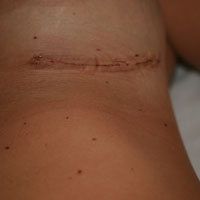
Scar at one week
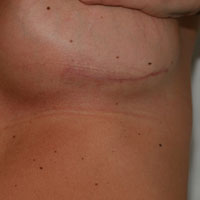
Scar at eight weeks
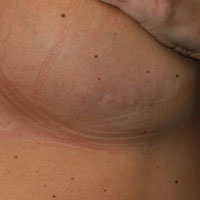
Scar at one year
After this, the proliferative stage takes place and continues for about three to four weeks. (To proliferate means to grow by rapid production). Fibroblasts (cells that are capable of forming skin and other tissue) gather at the site of injury. One of the most important duties of the fibroblasts is to produce collagen. Collagen is important because it increases the strength of the wound. The collagen continues to be produced for two to four weeks, pulling the edges of the wound together, and new capillaries (tiny blood vessels) are formed to aid the healing process. After this time, destruction of collagen matches its production and so its growth levels off. Abnormal scars can develop if this stage goes ‘faulty’.
The scar becomes thicker, red and contracts. It makes the scar more obvious and uncomfortable. The unpleasant appearance understandably causes some people concern at this point.
Finally, the remodelling stage begins and continues for a period from several weeks to a few years. Scar remodelling is what changes a thick, red, raised scar to a thin, flat, white scar and over the course of time, your scars will usually fade and become barely noticeable.
Personal factors that affect wound healing
How you heal will depend greatly on your genetics, for example, darker skin can produce darker and thicker scars.
- Certain illnesses such as diabetes, thyroid disease, high blood pressure and poor circulation can decrease the body's ability to heal.
- Nutrition - Studies show that your body needs zinc, vitamin C, protein, iron, adequate calories, vitamins and minerals to heal effectively.
- Your age - Younger people generally heal more easily than older people, but older people’s scars fade more rapidly.
- Non-smokers, on average, heal more quickly than smokers.
- Skin quality and blood supply to an area. For example, skin that has already been thinned and stretched through the weight of heavy breasts is at increased risk for raised, wide or irregular scars.
Abnormal scars - Keloids and Hypertrophic Scars
Keloids are large, bulky, raised, reddish scars that develop at the site of an injury or operation site. They can be very unsightly indeed. Unlike other scars, they gradually grow bigger.
This will of course depend on the operation site and a number of personal factors come into play. However, there are three distinct stages to healing and your scar will have a different appearance during each stage.
The three phases to healing are the inflammatory stage, the proliferative stage and the remodelling stage. The inflammatory stage begins immediately and lasts a few days. During this time, the bleeding stops and white blood cells come to the site and fight any infection. The wound at this point will look red and swollen and pink.
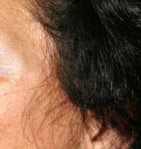
Normal Scar following a face lift
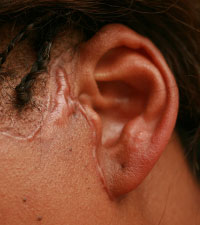
Keloid Scars
With keloids, the fibroblasts that make the collagen continue to multiply even after the wound is filled in. Thus, keloids grow above the surface of the skin and form large mounds of scar tissue. “It is often described as the scar that doesn’t know when to stop”, says Mr Henley.
Keloids can occur anywhere on the body, but are most common on the ears, neck, shoulders, upper arms, chest, or back. Symptoms include pigmentation of the skin, itchiness, redness, unusual sensations and pain. Although anyone can form a keloid scar, some ethnic groups are more at risk. People of African or Asian descent are more likely to develop keloids than people with lighter skin. However, people with ginger hair and very fair skin are also at increased risk of hypertrophic or keloid scarring. Men and women are equally affected.
Says Mr Henley, “The upper arm was specifically chosen as the most appropriate site for a TB vaccination on the basis that poor scarring could occur in that area. This allowed teams of doctors to quickly and easily check if populations had been vaccinated without the need to look at any medical records or other paperwork. All that had to be done was to line people up and inspect their left upper arms.”
There is a genetic component to keloid scarring. If someone in your family has keloids then you are at increased risk.
A hypertrophic scar looks similar to a keloid. Hypertrophic scars are more common, but they don't get as big as keloids and often subside by themselves (a process that can take up to one year or more). They occur in all racial groups.
A hypertrophic scar remains within the length of the original wound. If it grows beyond the original wound's boundary, it becomes a keloid scar.
Treatments for scars
Different scars need different treatments. Do not be surprised if Mr Henley advises leaving the scar alone for a while to see if this problem resolves on its own, particularly if it is less than a year old. Mr Henley might recommend compression therapy, intense pulsed light or laser therapy, steroid injections, application of a special silicone sheet or scar revision surgery.
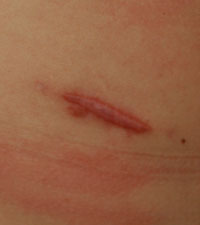
Hypertrophic Scar
Do scar treatment creams work?
There are a variety of skin treatment and scar creams out on the market. For some of the thickened, raised or hypertrophic scars, there have been some studies that show that silicone gel sheeting or other treatments do work. However, “For a healing, straightforward scar, I would leave it alone”, says Mr Henley, “although it is, of course, important to watch for further scientific advances in this field.”
What treatments are there for new scars in plastic surgery?
There has been a lot of research recently into laser treatment for young scars. Young scars are those that are within a year or two old. They are either pink or red and they don't have the mature, light quality of the older scars. Some of the lasers that are available now may be effective on newer scars, but some of the older scars probably won't benefit from laser treatment.
What can I do to give my wounds the best chance of healing?
"Cover up!" Mr Henley cautions, “Sun-block is vitally important if the scar is on exposed skin. Scars do not contain the normal pigments that protect skin and so burn easily. The sun can also either lighten or darken the scar and that's really what you want to avoid.” He advises to keep those scars or incision sites hidden from the sun. ”If you can't wear clothing, the best thing is SPF 30 or higher. This should be generously applied making sure all scar areas are covered.” When exercising, you can also cover any scars with a plaster. The plaster works as a splint, preventing the scar from being stretched or pulled too much.
Don’t smoke or use nicotine substitutes! Nicotine in any form (cigarette, patch, gum) causes the blood vessels to constrict. This decreases the delivery of oxygen to your wound, preventing sufficient nutrients from being delivered to allow adequate healing to take place.
Although oxygen delivery is important in any wound, it is especially important when the skin has been separated from underlying structures, creating a flap.
A flap is formed in many cosmetic procedures, such as face-lifts, neck-lifts, breast-lifts and tummy tucks. If you smoke, you are greatly increasing your chances that the skin flap will die, leaving you with an even larger problem than you started with. This is because among other things, cigarette smoke contains carbon monoxide, which reduces the oxygen carrying capacity of the red blood cells. It causes the small blood vessels in the skin to go into spasm and also causes the platelets, which start the blood clotting process, to become much stickier. This combination can cause the oxygen supply to the tissues to fail, killing the flap.
The risk of complications is so high for some cosmetic procedures that Mr Henley will not operate on you if you smoke. So, if you are planning cosmetic surgery, stop now and make sure that you can comfortably stay stopped before you plan any surgery.
Stick to the post-operative instructions! Too much movement can cause fluid to collect (swelling) and interfere with the laying down of collagen which is necessary to hold the wound together. In more drastic cases, the force of movement can pull the incision apart. In general, the less tension on the wound, the less the scar will widen with time. After surgery, Mr Henley may limit your exercise regime, range of movements, lifting or driving for a while. He may also supply you with special post-op compression garments to promote healing by limiting bruising and pushing excess fluid out of the operated area.
Have a healthy diet! A balanced diet will ensure that you have the right nutrients to promote healing. The body particularly needs a good supply of vitamin C to make collagen.